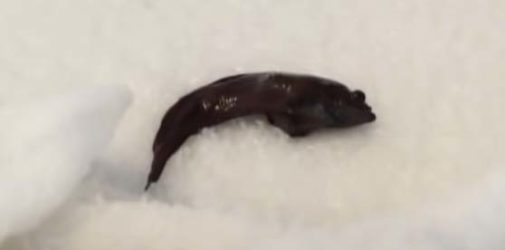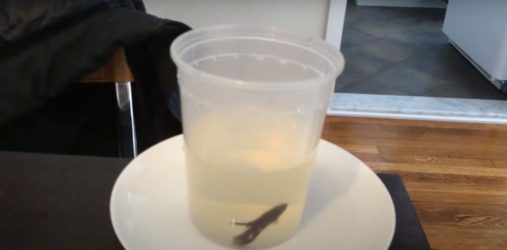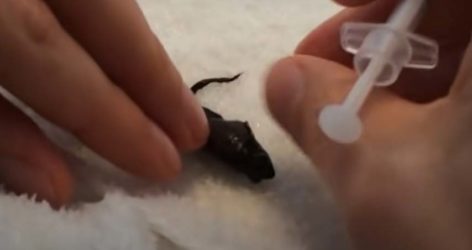Betta fish are a good pet because they are highly interactive and allow humans to bond. The beauty of betta fish is also a rival characteristic for other saltwater fish. Betta fishes are beautiful and likable to be kept in aquariums.
The betta fish species are affordable, and you can fit them almost anywhere. So you do not have to care much about maintaining their tanks and habitat adaptations. But one of the common problems is that they become dropsy betta fish over time. Dropsy condition refers to a swollen belly of the betta fish. Betta fishes are best until stricken with the disease. After they are struck with a disease or bad health, it’s very hard to revive them back into good health.
The swollen belly is a sign that your Betta Fish is not in good health. Most people ignore the symptoms because they don’t have much idea about them. Therefore, this guide is here to educate every betta fish owner about the symptoms of dropsy, and treatment for the same.
Table of Contents
What do you Mean by Dropsy Betta Fish?

You might have heard of dropsy betta fish even before this article, but you might be counting it as a specific disease. It is not completely true. The reason behind the dropsy symptoms might be some serious underlying health conditions. It is often caused by gram-negative bacteria and is common for a healthy fish to experience.
It is most likely common for fish that have weak immunity. Dropsy is similar to that of Edema in human beings. When the soft tissue fills up with fluid, your body cannot remove it naturally. As a result, this is termed bloating, and the body experiences negative symptoms.
Sign and Symptoms of Dropsy in Betta Fish

The major problematic concern for the dropsy condition is that several problems cause the early symptoms. And if you miss out on catching the symptoms of this condition within time, then it can increase the fatality risk in your betta fish rapidly. Therefore, here is a brief knowledge of the symptoms of dropsy betta fish, which you must observe to take immediate action.
Early Symptoms
It’s best to understand and look out for detaining the health of the betta fish before it contaminates the entire aquarium. Hence for your information, we have mentioned below a few symptoms. The early symptoms embedded within the dropsy betta fish are:
- Your betta fish will probably stop eating. Dropsy is just one possible cause your fish might not be eating. Therefore, consider the experts or caution before treating your fish straightaway for dropsy when you see them not eating any food.
- You might find that your betta fish avoids getting along with other fish in the tank. It is the opposite behavior to the character of betta fish. Therefore, this might be a probable sign that things are not good for your fish.
- A betta with dropsy problems often looks out for one spot within the tank and then hides there.
If your betta has experienced most of these symptoms, then it is not more than 2 to 3 days when you will start to observe their belly distending. Hence, this is where treating the dropsy problems becomes difficult. But, you must also evaluate that these symptoms are also caused due to excess stress and can also be caused due to stress.
Therefore, you should take some time to analyze and diagnose your fish’s symptoms before treating your betta for the dropsy conditions. It is so advised because if your betta fish is suffering these symptoms due to stress treating them for another disease might worsen the condition. As a result, their immune system will take the blow.
Noticeable Symptoms in Dropsy Betta Fish
Just like the early symptoms, there are some prominent ones as well. However, the prominent symptoms don’t leave any room for doubts. The three most common and noticeable signs in dropsy betta fish are:
- Suppose your betta fish has pinecone scales. It means that if all of the scales of your fish are sticking outside, just like that of a pinecone, then dropsy might be the evident cause for it. The major problem is that if you realize the dropsy condition of your betta fish at this stage, then the chances of survival are quite slim.
- A swollen and bloated stomach is yet another possible sign that can assure dropsy. Of course, a swollen belly can also indicate constipation, but if it lasts for longer, your fish scales can conclude it as dropsy without second thoughts.
- At times, the betta fish with dropsy will have the curved spine problem, which is very much unnatural to look at. It is mostly due to the swelling of organs that causes pressure and bends the spine of your fish. But if the spine bending is in the vertical direction, it is tuberculosis and not dropsy. But if the bend is horizontal, then it is dropsy for sure.
Other Symptoms
Some of the other probable symptoms that you can be possibly find in Dropsy betta fish are:
- Gills lose their vibrant color and become pale.
- Clamped fins are often swelling and painful, making it hard to move.
- Most betta fish swim at the tank’s topmost several times throughout the day. Therefore, naturally, your betta fish becomes reluctant to sink into the bottom of the tank.
- Red bulging anus or bulging eyes caused due to fluid retention of skin.
The early and major three symptoms are common, and you will notice more of them. The other symptoms are quite rare in dropsy betta fish, but over time and delayed treatment, you will possibly observe these critical symptoms as well.
Causes Of Dropsy in Betta Fish
The prime cause of dropsy in betta fish is poor diet, kidney failure, internal liver infections, bad osmoregulation, and other internal problems. Moreover, it is also caused due to swelling from the inside due to fluid build-ups. It imposes pressure against the body of your fish and abdominal region. This is the main reason the fluids are possibly formed within the betta fish’s body.
One of the other definite causes of dropsy is the aging aspects of betta fish. Aging bettas are vulnerable to kidney failure conditions, parasitic infections, and other viral, bacterial diseases. Hence, this is what gives rise to their dropsy symptoms as well. In addition, a high amount of bio-loads from the other tank mates or living in a small ecosystem will result in harmful infections.
It will also trigger the manifestation of several bacteria rapidly within the body of your betta fish. In addition, live food & proteins are not ideal for your betta fish to consume. That might just cause digestive problems in them and result in kidney failure. Hence, these causes will trigger the risk for your betta fish to experience dropsy conditions.
How To Prevent Dropsy In Bettas?

Amongst all of this bad news, one good factor is that dropsy is not common if you take proper care of your betta fish. However, Betta fish dropsy conditions are prevalent when you keep the fish in a 2 gallons bowl or poor water conditions. If you intend to prevent this factor, it is advised to have at least a 5-gallon fish bowl with a heater.
The water temperature should be 78 degrees Fahrenheit. A filter is also appreciated as it will help you maintain the water parameters. Reducing and preventing the stressors will also maintain the health of your immune system. With immunity, they can fight and resist the disease.
To prevent dropsy in betta fish, you must keep track of ammonia, nitrite, and nitrate levels. You can also use the feeding times to inspect the disease signs in your betta fish. Hence in this way, you can count on helping out your betta fish to avoid dropsy conditions.
How to treat dropsy in betta fish?

Dropsy in betta fish will become difficult to heal or cure at their advanced stages. If your fish suffers from extreme bloating conditions, it will increase the fatality rate. The general symptoms and other symptoms of the disease increase when unattended. So to avoid the progression of the disease, symptoms must be identified and taken care of before they cause other issues. Identifying it at the earliest will help you put up a successful treatment for your fish. Below are some instructions that you should follow to seek treatment for your betta fish:
- You need to set up a quarantine tank, preferably 5-gallon. Now, fill the tank with conditioned water and do not add up any living creature. Prefer to add some places within the quarantine tank for your betta to hide around and release stress. Add a heater to keep the tank water warm and make arrangements for keeping it oxygenated.
- Now, you need to add some aquarium salt to the quarantine tank. Follow the instructions specified by the aquarium salt brands for the ideal quantity of use.
- Now shift your betta fish to the quarantine tank with a proper acclimatization process.
- You should now make a 25% water change in the main tank to ensure that the other fish do not experience dropsy problems.
- If you have no other fish in your main tank, clean the filter and perform a 75% water change. Scrub everything in the tank with hot water and clean the live plants with warm water.
- You can use strong antibiotics such as amoxicillin for treating your betta fish. However, when using amoxicillin, you should strictly stick to the instructions specified on the label.
- As you are adding antibiotics and aquarium salt to the fish tank, you need to change the water daily to speed up the healing for your betta fish. Without it, you will be overdosing the fish with medicines, and the water will soon be deprived of oxygen.
The entire treatment process will last for around ten days. You need to monitor the fish closely during the treatment period to see if things worsen or improve. You also need to precisely stick to your manufacturer’s instructions to avoid overdosing your fish with medicines. Hence always look out for proper doses before giving them to your fish. Over-consuming the medicines may cause severe side-effects leading to fatality.
Do not stop the treatment in the middle as it may cause the bacteria to return stronger and resistant to even the strongest antibiotics. If you stop the medicines in between, there are high chances of this bacteria returning and growing again. Therefore, even if you feel like your betta is fit after a couple of doses, continue with the treatment even then.
Can Fish Recover From Dropsy?
Dropsy in betta fish or any other species can be recovered. But, it is not an easy process. Corrective treatment for the underlying problem will support the care system for betta fish and fish of other species. As stated above, dropsy is caused due to gram-negative bacteria and can be eliminated by broad-spectrum antibiotics only. Then, you can take them to the doctors to get a diagnosis. But keeping the symptoms and proper tracking of the progression of the disease.
The doctors or the pack itself will guide you with the ideal dosage. Follow them for the stipulated amount of time, and you will see how your health condition will improve on priority. Avoid doing medications on your own or searching for treatments on the internet. It will give rise to more complications and cause drastic consequences.
How Long Does a Fish With Dropsy Live?

A fish with dropsy dies as the ultimate result of negligence and lack of right treatment. Dropsy doesn’t kill them immediately, but it does in several months. There have been instances when the symptoms of dropsy vanish with minor treatments but return with more severe symptoms and cause adverse health distortion for the fish.
Dropsy Or Constipation?
There have been instances where people have counted on dropsy, a similar problem as constipation. If you seek treatment of your betta fish for dropsy, it can stress them out and deteriorate their condition when going through constipation problems.
The best way to differentiate dropsy from constipation is by noticing if your fish is properly passing stools or not. If they are not passing the stools over time, the symptoms probably indicate constipation. You can also differentiate the symptoms by realizing the amount of food you fed to your betta fish.
If you have fed too much for the day, you will probably experience bloating in your fish. There is a rule that you should feed high-quality food to your betta two times a day. And the quantity should be the same as that of the size of their eyeballs. If you let them eat anything more than this, it is constipation.
Conclusion
In the end, you should know that betta fish are sensitive to all negligence that new fish owners make. Therefore, if you are a new fish owner and want a betta fish in your aquarium, then count on following all of the specified instructions not just to keep them away from dropsy but all of the other health issues as well.
You can talk to experts to get a clear insight into how you can care for betta fish. Dropsy is one deadly and fatal disease or a sign of an underlying health condition that needs immediate attention. So spend a little more time with your aquatic pets while you feed them and check on any possible deformities they have or may have developed.
By doing that, you can eventually help yourself get a pleasant and happy betta fish without any kind of stress or health problems.
